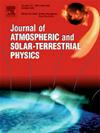Atmospheric ozone modulation by cosmic ray Forbush decreases: Patterns and anomalies across multiple stations
IF 1.9
4区 地球科学
Q3 GEOCHEMISTRY & GEOPHYSICS
Journal of Atmospheric and Solar-Terrestrial Physics
Pub Date : 2025-04-08
DOI:10.1016/j.jastp.2025.106509
引用次数: 0
Abstract
This investigation systematically examines the effects of 13 Forbush Decrease (FD) events on the total ozone column (TOC) and ozone concentrations within six stratospheric layers (L6–L11). The primary aim is to quantify the magnitude, temporal dynamics, and latitudinal variability of ozone responses to FD-driven CR perturbations. Using superposed epoch analysis, ozone data from 18 globally distributed stations (spanning 55.8°N to −6.2°N) were analyzed over a 21-day window centered on each FD event, with deviations calculated relative to a 4-day pre-FD baseline (days −4 to −1). Results reveal a distinct latitudinal gradient in ozone responses: high-latitude stations (e.g., Moscow, 55.8°N; Copenhagen, 55.7°N) exhibit rapid and substantial increases in TOC (5–15 %, peaking within 3–4 days) and layer-specific ozone concentrations (e.g., L6: 8–16 % by days 3–4; L11: 3–10 % by days 0–4), attributed to CR-induced ionization processes. Conversely, low-latitude stations (e.g., Jakarta, −6.2°N; Hanoi, 21.0°N) show subdued and delayed responses (TOC: 1–6 %; layers: 1–5 %, peaking by days 5–8), likely due to photochemical suppression and enhanced atmospheric mixing. Vertical analysis highlights more pronounced CR-driven effects in the lower stratosphere (e.g., L6), with greater variability in the upper layers (e.g., L11), indicating altitudinal differences in ozone sensitivity to CR flux variations. These findings emphasize the pivotal role of CR flux reductions in influencing stratospheric ozone dynamics, with broader implications for atmospheric chemistry, radiative forcing, and climate systems. The results underscore the necessity for further mechanistic investigations and advanced coupled chemistry-climate modeling to deepen our understanding of these intricate solar-terrestrial interactions.
大气臭氧受宇宙射线福布什衰减的影响:多个观测站的模式和异常现象
本研究系统地分析了13次Forbush reduction (FD)事件对6个平流层(L6-L11)总臭氧柱(TOC)和臭氧浓度的影响。主要目的是量化臭氧对fd驱动的CR扰动响应的幅度、时间动态和纬度变异。利用叠代历元分析,对全球分布的18个站点(覆盖55.8°N至- 6.2°N)的臭氧数据进行了为期21天的分析,以每个FD事件为中心,计算了相对于FD前4天基线(- 4至- 1天)的偏差。结果显示臭氧响应具有明显的纬度梯度:高纬度站(如莫斯科,55.8°N;哥本哈根,55.7°N)的TOC(5 - 15%,在3-4天内达到峰值)和层特异性臭氧浓度(例如,L6: 8 - 16%,在3-4天;L11: 3 - 10%(0-4天),归因于cr诱导的电离过程。相反,低纬度站(如雅加达,- 6.2°N;河内,21.0°N)表现出缓慢和延迟的响应(TOC: 1 - 6%;层:1 - 5%,在第5-8天达到峰值),可能是由于光化学抑制和增强的大气混合。垂直分析突出显示,平流层下层(如L6)的CR驱动效应更为明显,上层(如L11)的变率更大,这表明臭氧对CR通量变化的敏感性在高度上存在差异。这些发现强调了CR通量减少在影响平流层臭氧动力学方面的关键作用,对大气化学、辐射强迫和气候系统具有更广泛的影响。这些结果强调了进一步的机械研究和先进的耦合化学-气候模型的必要性,以加深我们对这些复杂的日地相互作用的理解。
本文章由计算机程序翻译,如有差异,请以英文原文为准。
求助全文
约1分钟内获得全文
求助全文
来源期刊

Journal of Atmospheric and Solar-Terrestrial Physics
地学-地球化学与地球物理
CiteScore
4.10
自引率
5.30%
发文量
95
审稿时长
6 months
期刊介绍:
The Journal of Atmospheric and Solar-Terrestrial Physics (JASTP) is an international journal concerned with the inter-disciplinary science of the Earth''s atmospheric and space environment, especially the highly varied and highly variable physical phenomena that occur in this natural laboratory and the processes that couple them.
The journal covers the physical processes operating in the troposphere, stratosphere, mesosphere, thermosphere, ionosphere, magnetosphere, the Sun, interplanetary medium, and heliosphere. Phenomena occurring in other "spheres", solar influences on climate, and supporting laboratory measurements are also considered. The journal deals especially with the coupling between the different regions.
Solar flares, coronal mass ejections, and other energetic events on the Sun create interesting and important perturbations in the near-Earth space environment. The physics of such "space weather" is central to the Journal of Atmospheric and Solar-Terrestrial Physics and the journal welcomes papers that lead in the direction of a predictive understanding of the coupled system. Regarding the upper atmosphere, the subjects of aeronomy, geomagnetism and geoelectricity, auroral phenomena, radio wave propagation, and plasma instabilities, are examples within the broad field of solar-terrestrial physics which emphasise the energy exchange between the solar wind, the magnetospheric and ionospheric plasmas, and the neutral gas. In the lower atmosphere, topics covered range from mesoscale to global scale dynamics, to atmospheric electricity, lightning and its effects, and to anthropogenic changes.
 求助内容:
求助内容: 应助结果提醒方式:
应助结果提醒方式:


